| View previous topic :: View next topic |
| Author |
Message |
TonyGosling
Editor


Joined: 25 Jul 2005
Posts: 18335
Location: St. Pauls, Bristol, England
|
 Posted: Thu Dec 31, 2020 7:56 pm Post subject: 25Aug1942 Prince George dies in Sunderland W4026 crash Posted: Thu Dec 31, 2020 7:56 pm Post subject: 25Aug1942 Prince George dies in Sunderland W4026 crash |
 |
|

| Whitehall_Bin_Men wrote: |
A NORTH Wales woman believes she holds the key to the death of controversial Prince George, Duke of Kent.
By North Wales Live 22 DEC 2003
https://www.dailypost.co.uk/news/north-wales-news/scandal-of-a-royal-d eath-2935893
A NORTH Wales woman believes she holds the key to the death of controversial Prince George, Duke of Kent.
Her uncle was the sole survivor of a World War II plane crash, which claimed the lives of 15 men.
One of the dead may even have been the Duke's boyfriend.
Her uncle dragged the royal and his fellow crewmen from the blazing wreckage, suffering terrible burns as he fought to save them.
He later told his family the Duke was at the controls - not the man who eventually was blamed.
For the first time in more than 60 years the relatives of Flt Sgt Andrew Jack have broken their silence.
His niece Margaret Harris, 69, of Prestatyn, has told how her uncle was ordered by the RAF not to reveal any details concerning the accident in order to protect the reputation of the Duke.
The Duke was the youngest brother of George VI and said to be a drug user, alcoholic and bisexual. Sgt Jack believed an unnamed passenger aboard the fateful flight was really the Duke's boyfriend.
This then paved the way for the official inquiry to blame the crash on the aircraft's pilot Flt Lt Frank Guyen.
The Sunderland flying boat ran into a mountainside as it headed from Invergordon in Scotland on the morning of August 25, 1942.
It was this injustice which haunted Sgt Jack for the rest of his life. As official documents never emerged, little has ever really been known about the matter.
"My uncle knew the pilot wasn't to blame yet he couldn't say anything," explained Mrs Harris.
"As a result he felt he'd let his mate down and this had a profound effect on him for the rest of his life.
"He was never the same after the accident, not because of the injuries he sustained, but because of the terrible injustice he was powerless to put right.
"The thought of the pilot's family believing he had crashed the aircraft was to erode into his conscience until his dying day."
Having survived the crash he dragged all 15 passengers from the aircraft sustaining terrible burns. Tragically, none of the others survived.
"He wouldn't have sustained any injuries had he not tried to save the other passengers," said Mrs Harris.
"But as a result of his actions he had to undergo plastic surgery on several occasions to improve the condition of his face and hands.
"It was when he returned to the aircraft to try to save those on board that he saw the Duke slumped in the pilot's seat.
"There was no doubt that he had been flying the plane."
Sgt Jack, then a rear gunner and navigator, had survived the accident as the rear section of the aircraft had broken off immediately after the crash, softening the impact.
However, he had questioned in his own mind whether the aircraft should have taken off at all.
"The plane was heading for Iceland where the Duke was to inspect Allied forces but had been delayed because of bad weather," explained Mrs Harris.
"The situation hadn't improved much when the Duke and his three associates got tired of waiting and decided they should set off.
"All three had been drinking and even though the crew had not, the Duke decided to fly the aircraft with fatal consequences."
One part of the mystery which remains concerns the identity of an extra passenger on the plane. There were 16 aboard instead of the scheduled 15.
"My uncle didn't say whether the person was male or female," said Mrs Harris.
"But everything points to the person being the boyfriend of the Duke as earlier they had been seen wearing make-up while still at the RAF base.
"There was something there that they wanted to hush up and a scandal of that nature in those days would have been explosive. "I recently saw a report suggesting that there was nothing sinister about the accident. It was then that I thought, 'I'm not having this', and decided to tell people what I know.
"Uncle Jack always hoped the truth would come out." |
Secret of duke's plane death
http://news.bbc.co.uk/1/hi/wales/north_east/3342953.stm
Tuesday, 23 December, 2003, 13:33 GMT
Margaret Harris with a picture of her uncle
Margaret Harris says she believes the duke was piloting the aircraft
A pensioner left with a family secret ever since a royal was killed in a wartime plane crash has spoken out to protect her dead uncle's memory.
Margaret Harris, from Prestatyn, is the niece of the sole survivor of the accident which killed 15 people including the Duke of Kent, the Queen's uncle.
She claims that for years her family have been burdened with the truth of what happened on that fateful day in August 1942.
Mrs Harris, 69, says the duke was piloting the ill-fated aircraft and a mysterious, unnamed person on board could have been the married royal's boyfriend.
He died when the Sunderland flying boat crashed in Scotland on its way to Iceland.
An official inquiry later ruled that an aircraft pilot was flying the plane and he was blamed for the accident.
However, in a new twist, Mrs Harris says the duke himself was actually behind the controls and she has finally revealed what her uncle, Flight Sergeant Andrew Jack, said happened in the crash.
Flt Sgt Andrew Jack
Sgt Jack was the sole survivor of the crash in August 1942
"He[my uncle] actually pulled him out of the pilot's position," she said.
It was her uncle Flight Sergeant Jack, who died in 1976, dragged the duke's body out of the wreckage.
Her uncle, who later married and had two sons, was devastated that his colleagues on board the flying boat were blamed for the crash when he believed it was the fault of the duke.
"What got to him was his mates being blamed for an accident that wasn't their fault," she added.
But she said pressure was brought to bear on her uncle to keep the facts of what happened hidden.
"He was left in no doubt it was to remain a secret. He was in hospital and with burnt, bandaged hands he had to sign a paper, possibly the Official Secrets Act."
Confidence
Sgt Jack was visited in hospital by the duke's mother Queen Mary and his widow but Mrs Harris said he could not keep what he saw a secret from his family.
"He only told my dad in confidence, it became to much for him one night and he told him.
"A mysterious extra person was on the plane he said.
"He never, ever mentioned who the person was and he never went into detail of whether it was a man or a woman.
"But he did say it was someone who shouldn't have been on (the plane).
"I think that perhaps that extra person might've had a bearing on the situation. Also the duke was not supposed to be flying that plane and they wouldn't want him blamed for people's deaths."
The pensioner said she hopes people will now finally believe what her uncle had kept hidden once and for all.
| Description: |
|
| Filesize: |
259.74 KB |
| Viewed: |
320 Time(s) |
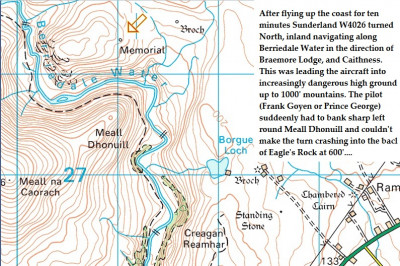
|
| Description: |
|
| Filesize: |
52.58 KB |
| Viewed: |
314 Time(s) |
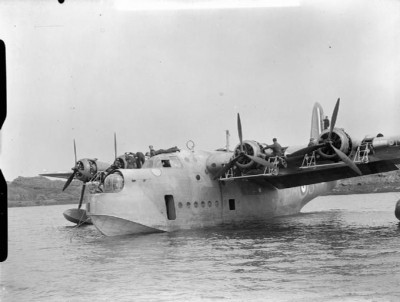
|
| Description: |
|
| Filesize: |
33.17 KB |
| Viewed: |
309 Time(s) |
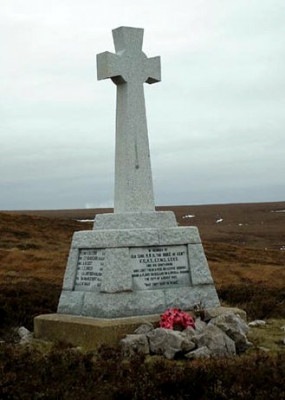
|
_________________
www.lawyerscommitteefor9-11inquiry.org
www.rethink911.org
www.patriotsquestion911.com
www.actorsandartistsfor911truth.org
www.mediafor911truth.org
www.pilotsfor911truth.org
www.mp911truth.org
www.ae911truth.org
www.rl911truth.org
www.stj911.org
www.v911t.org
www.thisweek.org.uk
www.abolishwar.org.uk
www.elementary.org.uk
www.radio4all.net/index.php/contributor/2149
http://utangente.free.fr/2003/media2003.pdf
"The maintenance of secrets acts like a psychic poison which alienates the possessor from the community" Carl Jung
https://37.220.108.147/members/www.bilderberg.org/phpBB2/
Last edited by TonyGosling on Fri Jan 01, 2021 1:46 pm; edited 5 times in total |
|
| Back to top |
|
 |
TonyGosling
Editor


Joined: 25 Jul 2005
Posts: 18335
Location: St. Pauls, Bristol, England
|
 Posted: Thu Dec 31, 2020 10:16 pm Post subject: Posted: Thu Dec 31, 2020 10:16 pm Post subject: |
 |
|
The Dunbeath air crash - more commonly referred to as The Eagle's Rock Crash - involved the loss of a Mark 3 Short S.25 Sunderland W4016 of 228 Squadron (Coastal Command) that crashed in the Scottish Highlands on a headland known as Eagle's Rock (Creag na h-Iolaire) near Dunbeath, Caithness on 25 August 1942.
http://aircrewremembered.com/crash-at-eagles-rock-sunderland-w4026.htm l
The crash killed 14 of 15 passengers and crew, including Prince George, Duke of Kent, who was on duty as an Air Commodore in the Royal Air Force on a mission to Reykjavik; a message of condolence was proposed in Parliament by the British Prime Minister. A Royal Air Force Board of Inquiry determined that the crash was the result of a navigational error by the crew. But to many this looked like a whitewash.
The Sunderland had not long taken off from its base at 228 Squadron (Coastal Command) in the Cromarty Firth. The crash had ignited the aircraft's newly topped-up fuel tanks and the subsequent fireball had virtually destroyed everything. Such incidents were apparently not rare. The North Highlands, with its mountainous terrain and challenging weather systems, had claimed numerous other victims during the war years. What singled out this accident, above all others, was the the death of HRH the Duke of Kent.
The aircraft and crew were assigned a VIP transport mission to RAF Reykjavik, specifically to transport Prince George, Duke of Kent to Iceland. The aircraft departed from a seaplane base at RAF Invergordon on the Cromarty Firth at 1305 GMT on Sunday 25 August 1942 into foggy weather. The Sunderland (flying on instruments) veered off its flight plan track and crashed into the remote Eagle's Rock at 13:42 GMT. The official board of inquiry concluded that the plane crashed into the hillside due to an error of navigation; i.e. there was not enough allowance made for wind that caused the aircraft to drift off its planned track up the eastern coast of Scotland. Fourteen of the fifteen crew and passengers, including HRH The Duke of Kent, perished in the crash.
On the day of the crash, the aircraft had taken off from the Cromarty Firth at Invergordon, and then flown up the coast. The flight plan was for the aircraft to fly parallel with the east coast of Sutherland and Caithness until it reached Duncansby Head, where it would turn north west and head directly for Iceland.
Take-off: RAF Invergordon - Planned turn point: Duncansby Head - Crash Site: Eagle's Rock
It remains a mystery why the aircraft turned inland when it did, and it is a still greater mystery why it had descended to 700ft by the time it struck the ground. The crew on board was hand-picked and highly unlikely to make a navigational error of the scale necessary to suggest they simply turned north west too early. And while there was patchy cloud around, visibility ought to have been sufficient for the crew to see they were flying into hills.
Once described by Prime Minister Winston Churchill as a ‘gallant and handsome prince’, George Edward Alexander Edmund, the popular Duke of Kent, was the youngest brother of the reigning monarch, King George VI. Fifth in line to the throne, the duke had much to live for; he and his wife, Princess Marina, had just celebrated the birth of their son, Michael, only seven weeks previously. In his position as an air commodore he had responsibility of the welfare of RAF personnel and, as the inscription on the memorial at Eagle's Rock records, he was killed on a ‘special mission’.
Sir Archibald Sinclair, then Secretary for Air, reported to the House of Commons the official investigations had revealed: ‘First, that the accident had occurred because the aircraft was flown on a track other than that indicated on the flight plan given to the pilot and at too low an altitude to clear the rising ground on the track; secondly, that the responsibility for this serious mistake in airmanship lies with the captain of the aircraft; thirdly, that the weather encountered should have presented no difficulties to an experienced pilot; fourthly, that the examination of the propellers showed that the engines were under power when the aircraft struck the ground; and fifthly, that all the occupants of the aircraft were on duty at the time of the accident.’
However, a number of issues remained unresolved. The flight crew were all hand-picked and vastly experienced aviators. The question was asked why, at such an early stage in the flight and in such poor visibility, did they veer away from the planned flight path and drop altitude over known hilly terrain? A lack of official documentation, much of which went missing, together with denied access to the, albeit limited, royal archives, has over the ensuing years, fuelled speculation and conspiracy theorists. One theory is that enemy infiltrators tampered with the flight before it took off from Invergorden. It is alleged that a secret report received by German foreign minister Joachim von Ribbentrop, on 5 December 1942, claimed the Duke of Kent was apparently sympathetic to a peaceful understanding with Germany and an internal sabotage plot had been carried out as a last resort to avoid a potentially embarrassing ‘problem’ for Britain.
Incredibly, one of the members of the flight crew survived the crash: Flight Sergeant Andrew Jack was the tail gunner, his turret broke off on impact. Miraculously he had survived the fireball which engulfed Eagle's Rock. Confused, disorientated and suffering from burns to his face and body he had wandered aimlessly in the misty conditions before his discovery by the Sutherland family at their remote croft at Rinsary, the following day. Flight Sergeant Jack claimed to have crossed many bridges whilst lost, there are four footbridges in the area so the family concluded he must have been going around in circles.
It is known while in hospital in Wick, Jack was visited privately by two senior RAF officers. Some believe he was forced to sign the Official Secret Act because, until his death in 1978, he refused to answer questions in connection with the accident. He did allude to his personal belief that the crash was not due to pilot error and no ‘serious mistake in airmanship’ could be attributed to the aircraft's official captain. However, he would not elaborate further.
The official investigation had blamed Flight Lieutenant Frank Goyen, the Sunderland's pilot and captain. However, Goyen was not the senior officer on board. In the last minutes before take off the crew had been joined by Wing Commander Thomas Mosley 228 Squadron's Commanding Officer. And the Duke, of course, held the rank of Air Commodore.
A more plausible explanation is the allegation that friends of the duke were known to be staying at Langwell House very close to the crash site and the last known message heard from the flight deck was ‘Let's go down and have a look...’ The question raised is just exactly whose hands were on the controls at the moment of impact? Listening on the intercom in the rear of the aircraft Jack would have known exactly what was taking place but his version of accounts was never disclosed.
Members of the Royal Family still visit Eagle's Rock from time to time. It has become a focal point for their grief. King George VI had made his own special pilgrimage not long after the crash. The Celtic cross, bearing the names of those who died, records how they had died while on a ‘special mission’, a mission that ended in disaster.
Those on Board at the time of the crash were:
Air Commodore HRH The Duke of Kent.
Lieutenant John Crowther, RNVR Private Secretary.
Pilot Officer The Hon. Michael Strutt.
Leading Aircraftman John Walter Holes, Batman.
Flight Lieutenant Frank McKenzie Goyen, Captain.
Wing Commander Thomas Mosley, Commanding Officer of 228 Squadron, 1st pilot.
Pilot Officer Sidney Wood Smith, 2nd pilot.
Pilot Officer George Saunders, Navigator.
Flight Sergeant William Jones, Flight Mechanic Engineer / Air Gunner.
Flight Sergeant Charles Lewis, Airframe Fitter.
Flight Sergeant Ernest Hewardine, Wireless Operator / Air Gunner.
Sergeant Edward Blacklock, Wireless Operator / Air Gunner.
Sergeant Arthur Roland Catt, Wireless Operator / Air Gunner.
Sergeant Leonard Sweett, Fitter.
Sergeant Andrew Jack, Wireless Operator / Air Gunner.
The crash remains an unsolved mystery and the views of those who, having studied the facts as they are known to them, still insist that whatever caused the ill-fated flight to crash, it was not pilot error. It seems that the crash (not rare by the standards of the time) was just a terrible accident - the fact that will never be known is who was really at the controls at the time of the crash.
Duke of Kent Marker
In 1946 the Ministry of Works asked a local contractor to erect two memorials at the site. The first, in the form of a Celtic cross rising from a plinth, commemorates all those who died that day. The second, to the north and out of sight of the first, marks the place where the body of the Duke of Kent was found.
| Description: |
|
| Filesize: |
240.46 KB |
| Viewed: |
306 Time(s) |
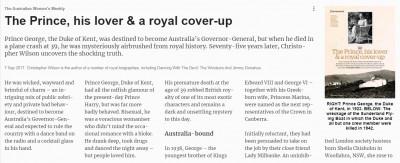
|
| Description: |
|
| Filesize: |
301.05 KB |
| Viewed: |
309 Time(s) |
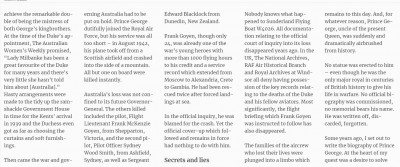
|
| Description: |
|
| Filesize: |
250.08 KB |
| Viewed: |
315 Time(s) |
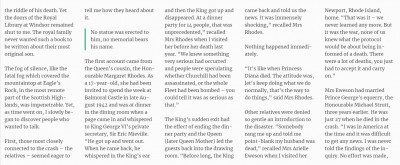
|
| Description: |
|
| Filesize: |
282.66 KB |
| Viewed: |
316 Time(s) |
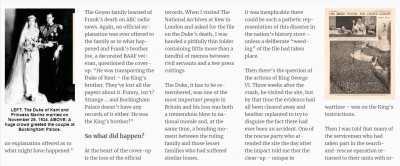
|
| Description: |
|
| Filesize: |
297.9 KB |
| Viewed: |
313 Time(s) |
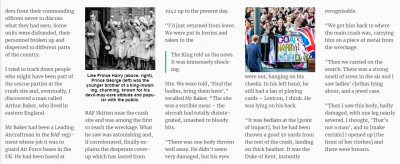
|
| Description: |
|
| Filesize: |
313.63 KB |
| Viewed: |
313 Time(s) |
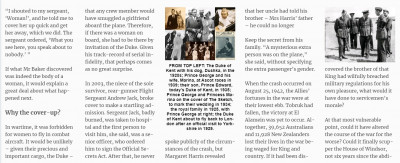
|
| Description: |
|
| Filesize: |
264.17 KB |
| Viewed: |
318 Time(s) |
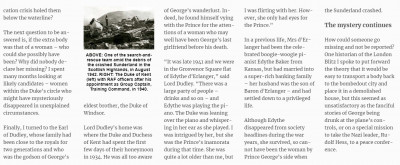
|
| Description: |
|
| Filesize: |
224.92 KB |
| Viewed: |
321 Time(s) |
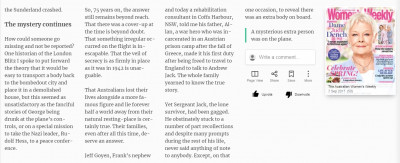
|
_________________
www.lawyerscommitteefor9-11inquiry.org
www.rethink911.org
www.patriotsquestion911.com
www.actorsandartistsfor911truth.org
www.mediafor911truth.org
www.pilotsfor911truth.org
www.mp911truth.org
www.ae911truth.org
www.rl911truth.org
www.stj911.org
www.v911t.org
www.thisweek.org.uk
www.abolishwar.org.uk
www.elementary.org.uk
www.radio4all.net/index.php/contributor/2149
http://utangente.free.fr/2003/media2003.pdf
"The maintenance of secrets acts like a psychic poison which alienates the possessor from the community" Carl Jung
https://37.220.108.147/members/www.bilderberg.org/phpBB2/ |
|
| Back to top |
|
 |
TonyGosling
Editor


Joined: 25 Jul 2005
Posts: 18335
Location: St. Pauls, Bristol, England
|
 Posted: Fri Jan 01, 2021 1:09 pm Post subject: Posted: Fri Jan 01, 2021 1:09 pm Post subject: |
 |
|
| Quote: |
Winston Churchill and the death of Prince George, Duke of Kent
I've read various diaries and official accoounts of what was happenind at the supposed destination at around this time. In no particular order:
1. there was an issue re blackmarket dollars and the use of the Icelandic Kronu by service men, and employmnent, or not, of local labor.
2. there was a large shipment of Gold Bullion passing through.
3. There was a rapid escalation of German interest in the area around August including surreptitious setting up of German weather stations on a nearby island (part of Greenland)
4. there was shortly to come a rapid de-escalation of German interest as the Russia war was biting deep into German resources.
5. at the time of the crash, the British HQ on Iceland had only just completed handing over to the US.
6. There was a significant Icelandic pro German sentiment.
7. Iceland was a valuable position for predicting weather for the European theatre. There are accounts that these days of August 42 had a window of clear weather.
8 A flight from Iceland the day before had dropped off 'a courier' in Scotland"
IIIIIIIIIIIIIIIIIIIIIII
"The crash was heard by local people and reached the scene of the accident about 90 minutes after they heard the explosion. This included a doctor (John Kennedy) and two policemen (Will Bethune and James Sutherland). They found 15 bodies. This included the body of the Duke of Kent. Bethune gave a radio interview in 1985 where he described finding Prince George’s body. He said that handcuffed to the Duke’s wrist was an attaché case that had burst open, scattering a large number of hundred-kroner notes over the hillside."
Icelands currency is 1 Krona, 100 Kronur.
In Norway, Denmark and Greenland it's the Kroner. in Sweden the Kronor.
If indeed it's correct that it was hundred-kroner notes then if they were going to Iceland the money would meant be for Greenland?
Flying with a hundcuffed wrist could be dodgy?
Edited May 26, 2007 by John Dolva
John Simkin
Admin
John Simkin
Admin
15,700 posts
Gender:Male
Author
Posted May 26, 2007
David Richardson said:
This is the AC2 diary extract:
From Don Macfie’s Diary
August 25, 1942 – This evening an aircraft (Sunderland) from 228 Squadron RAF crashed into a Scottish hillside with the Duke of Kent on board. All were killed with the exception of rear gunner Flt/Sgt Andy Jack. P/O Saunders the Navigator was with us in Debert NS. That is eight Debert boys lost since we came over in June.
August 27 – We flew over to Invergordon today, taking the CO of 288 over to see about the return of the bodies from the crash. We went up Caledonia Canal and by Inverness. We flew up the valley between the mountains. It was really the nicest scenery I had ever seen.
Note: some weeks later at Oban I was standing at a bar and noticed Andy Jack beside me. He was jut out of hospital minus most of his nose. I asked him what had happened. He leaned over and whispered, “I think the Duke was flying.”
BTW, I'm not a historian in any sense of the word, so I hope I'm not irritating the *real* historians by dredging up stuff like this!
It seems that Andy Jack told several people that he thought the Duke of Kent was flying. For example, he told the story to Corporal Tim Watson who served with Andy Jack in Oban. In 1943 Jack told Watson that just before the flying boat took off Mosley was in number 1 seat and Goyen was in the number 2 position. The Duke of Kent stood behind and in between the two men. Jack then went to his seat in the rear of the aircraft. The significance of this is that it might have been Mosley rather than Goyen who piloted the aircraft.
However, Andy Jack was not in a position to know who was flying the aircraft. He was the tail gunner. The only radio contact he had with the cockpit was 10 minutes into the flight.
The Duke of Kent was identified at the scene of the crash. However, that was not the case of the pilot and co-pilot who were badly burnt. This suggests that the Duke was not in the cockpit.
The other problem with this story is that when Will Bethune found the Duke's body, he had an an attaché case handcuffed to his wrist. This would have made it difficult to fly the plane.
The reliability of Andy Jack as a witness is a problem. After checking that everyone on board was dead he broke RAF regulations by leaving the scene of the accident. Andy Jack did not arrive at Mrs Sutherland’s cottage until 1.30 the next afternoon. That means that he was missing for nearly 24 hours. That is why his sister was informed by the RAF that Jack had been killed in the accident.
I think Andy Jack spread this story about the Duke of Kent being at the controls to explain why there was a cover-up. The Royal Family have also gone along with this cover-up. (It is almost certain that the documents related to this accident are being kept in the Royal Archives. The Freedom of Information Act does not apply to the Royal Archives and they therefore will never be released. But would the government and the royal family cover up this accident just to protect the reputation of the Duke as a pilot? I don't think so. However, they would be willing to do so if the Duke was involved in an act of treason. That is something that could have brought an end to the monarchy.
Charles Black
Advanced Member
Charles Black
Members
592 posts
Location:Florida
Interests:History<br />Sports<br />Fishing<br />Shooting
Posted May 26, 2007
As I mentioned in an earlier post, I on numerous ocassions during the 1960's, have been "so handcuffed" to a satchel. Flying an aircraft, other than for watching it on "auto pilot" would be impossible...particularly on a military mission.
Tho not large, such a satchel is cumbersome enough that one cannot even take off a jacket. Putting on a parachute (if not done so before satchel attachment) would be "impossible" in the event of an air "emergency". I from experience, strongly feel that the thought of his piloting the aircraft should be set aside.
There IS something seriously wrong with the various Andy Jack reported actions and reactions which I personally don't feel, at this late date, could ever be resolved. A twenty four hour absence? Yet he wasn't injured enough to investigate the crash site?
Given the number of people involved, my military experience would indicate to me that this Was Not a "treasonous" mission.
Perhaps things are different in the U.K., but in the U.S., I feel that the "National Security" excuse would be used nearly "eternally".....or until every possible flaw has been without question eliminated.
In the U.S., the crash of a "private flight" which concerned the death of a pro JFK conspiracist, Congressman Hale Boggs, over Alaska, is hampered by National Security considerations which MUST be considered as a fabrication. Theoretically, the aircraft was never found.
I find this subject very interesting, tho I feel that we might be attacking windmills.
Charles Black
Len Colby
Super Member
Len Colby
Members
7,469 posts
Gender:Male
Location:Brazil
Posted May 26, 2007
“August 25, 1942 – This evening an aircraft (Sunderland) from 228 Squadron RAF crashed into a Scottish hillside with the Duke of Kent on board. All were killed with the exception of rear gunner Flt/Sgt Andy Jack. P/O Saunders the Navigator was with us in Debert NS. That is eight Debert boys lost since we came over in June.”
I found this diary entry a bit suspect since as John pointed out Jack was not found till the next day (the 26th) and had previously been presumed dead. Also crash happened some time between 1:30 and 2:30 presumably someone at Oban would have known that
I don’t think Jack leaving the crash site suspicious. Soldiers have been disobeying orders especially standing orders since long before WW2 and the instinct towards self-preservation probably took precedence. Assuming he had the presence of mind to remember the order he probably preferred being a live soldier punished for violating an order than a dead one honored for obeying it.
John is there any collaboration for Bethune’s claim made 42 years after the fact about the “attaché case handcuffed to his wrist” and the money? Odd that if true no one else would have mentioned it. Can we even be sure he was there?
Another reason to doubt that Hess was the “15th man” is that decades later he was repeatedly visited by his wife in son in Spandau. If the man there were an imposter he fooled them or for reasons unexplained they went along with the subterfuge.
John Dolva – I’m interested in the “courier” “dropped off in Scotland" by “a flight from Iceland the day before” the crash can you elaborate and/or provide a citation?
As for the Boggs crash I haven’t seen a reliable citation that he believed the JFK assassination was a conspiracy. His daughter, Cookie Roberts, said he didn’t
Shanet Clark
Super Member
Shanet Clark
Members
1,604 posts
Gender:Male
Location:US/Georgia 9/06- PHOTO ON FILE VIA URL
Interests:Masters in Education; B.A. (Summa Cum Laude) History. GSU.
Posted May 26, 2007
Interesting webpage on the event.
Looks like the MCADAMS version of the Duke of Kent death !!!
David Richardson said:
I came across this site when I Googled the serial number of the plane:
http://www.ww2inthehighlands.co.uk/folders...erlandw4026.htm
Interesting take on Andy Jack + some photos.
Michael Chapman
Experienced Member
Michael Chapman
Members
68 posts
Posted May 26, 2007
Mr Simkin,
I await your promised posts on the Duke of Kent's 'accident' and Churchill's 'real intentions' with interest. At the moment it looks like you can't see the wood for the trees. Perhaps this little chestnut might aid your vision:
In the late '20's a new Tory MP took exception to Churchill's continual grizzling duing his maiden speech. Churchill finally snapped when the young Turk referred to Labour members as 'the enemy.'
'You fool' said Churchill, 'that's the opposition, the enemy is behind you!'
Now Mr Simkin, ask yourself these questions:
1) What was the real reason behind the formation of the SOE?
2) Ditto the CIA?
Remember, the universe consists largely of DARK matter...
John Dolva
Super Member
John Dolva
Members
11,499 posts
Gender:Not Telling
Location:Australia
Interests:remembering the two towers of 13,000 children that fall down, dying of starvation, preventable diseases, lack of clean water and basic health needs every 1 1/2 hours 24/7/365... 9/11? Bah... ...Viva Che'... living in a nice world
Posted May 26, 2007 (edited)
Len I'm pretty sure it's this one - 2 days before. My mistake "8-15" + "nine-day" = 24
http://www.firebirds.org/menu1/moranp_5.htm
...Reykjavik Air Base, Iceland. Another lengthy delay due to storms in the North Atlantic. We had some excitement on 8-15, when a German four-engine Focke-Wulf "Kondor", which strongly resembled a B-17, made a bomb run on the base. The Kondor was Germany's only long-range bomber, and was the eyes and ears of the U-Boats which were harassing our convoys. Two pilots of the air defense force, flying a Bell P-39 "Airacobra" and a Curtiss P-40 "Warhawk", immediately took off to intercept the intruder, which was shot down in flames moments later, marking the first American aerial victory in the Atlantic/European Theatres of Operations. After a nine-day delay at Reykjavik, weather clears enough for us to take off on our final overwater leg.
23 Aug 42 - RAF Prestwick, Scotland. After an uneventful flight, we land at RAF Stomoway, in the Outer Hebrides Islands, to drop off a courier and to refuel. The short flight to Prestwick was most interesting as we hedge-hopped over small islands and beautiful, green Scottish hills and fields. [880 mile leg] We RON and are feted by a dance in the town hall, to the tune of drums and bagpipes.
Edited May 26, 2007 by John Dolva
John Dolva
Super Member
John Dolva
Members
11,499 posts
Gender:Not Telling
Location:Australia
Interests:remembering the two towers of 13,000 children that fall down, dying of starvation, preventable diseases, lack of clean water and basic health needs every 1 1/2 hours 24/7/365... 9/11? Bah... ...Viva Che'... living in a nice world
Posted May 27, 2007
The currecy is significant. reported as "100-Kroner" bills
Either
-it is an incorrect record
-it is manufactured by someone who did not know the difference
-it is correct.
Iceland 100-Kronur
Greenland 100-Kroner
Denmark 100-Kroner
Norway 100-Kroner
Sweden 100-Kronor
What use was 100-Kroner bills in Iceland?
If it is correct that the Duke was carrying a case of 100-Kroner bills to Iceland then that means something. One would need to consider their (the bills) destination to a Greenland element.
If it is correct that the plane was heading elsewhere, then Denmark or Norway becomes an issue, both Nazi occupied countries.
Or...?
John Simkin
Admin
John Simkin
Admin
15,700 posts
Gender:Male
Author
Posted May 27, 2007
Michael Chapman said:
I await your promised posts on the Duke of Kent's 'accident' and Churchill's 'real intentions' with interest. At the moment it looks like you can't see the wood for the trees. Perhaps this little chestnut might aid your vision:
In the late '20's a new Tory MP took exception to Churchill's continual grizzling duing his maiden speech. Churchill finally snapped when the young Turk referred to Labour members as 'the enemy.'
'You fool' said Churchill, 'that's the opposition, the enemy is behind you!'
Now Mr Simkin, ask yourself these questions:
1) What was the real reason behind the formation of the SOE?
2) Ditto the CIA?
Remember, the universe consists largely of DARK matter...
At this stage it might be worth considering the theory put forward by the authors of “Double Standards: The Rudolf Hess Cover-Up”. Three journalists/historians had been working independently on different events during the Second World War. Lynn Picknett, Clive Prince and Stephen Prior joined forces to write the book initially published in 2001. I have a copy of the revised edition that takes into account of the witnesses that came forward in reaction to the first edition. I do not fully accept this theory of events but it does provide a structure that will enable an informed debate on the subject.
Picknett, Prince and Prior rely heavily on Robert Brydon’s research into the death of the Duke of Kent. They are also indebted to Hugh Thomas (The Murder of Rudolf Hess – 1979) who provided the evidence that suggested that the man in Spandau Prison was not Rudolf Hess.
The authors of Double Standards argue that the Flying Boat flew to Sir Archibald Sinclair’s Baremore Lodge in order to pick up Rudolf Hess. As I pointed out in an earlier posting, one of the surprising things about this story was that Sir Louis Greig was not on board. Greig had been the Duke of Kent’s constant companion over the previous few months. Was Greig spying on the Duke? Is it relevant that he had been the former secretary of Sir Archibald Sinclair and a close confidant of Winston Churchill? Was Greig warned that the aircraft would crash?
The authors argue that the destination was Sweden rather than Iceland. Sweden was a neutral country that had been used before to negotiate between the UK and Germany during the war.
The authors argue that only the British government could have organized the accident and ensured the cover-up. They also point out the similarities with other flying incidents that involved people who were inconvenient to the government.
In November 1942, General Wladyslaw Sikorski, the leader of the Polish government in exile, boarded a Lockhead Hudson at Montreal. On take-off, when the plane was only 30 feet in the air, both engines cut out. The pilot was able to make a successful emergency landing.
In March, 1943, General de Gaulle, needed to visit Glasgow. The General hated flying and intended to take the train from London. Sir Archibald Sinclair persuaded him to change his mind and take a Wellington bomber from RAF Hendon to Abbotsinch near Glasgow. However, the plane’s elevators failed to respond. The pilot was able to make a successful emergency landing. A secret RAF investigation discovered that the control rods had been eaten through with acid and that this was a clear case of sabotage. The investigation blamed German infiltrators but the culprits were never caught. This report was not released until 1967. Other recently released documents show that during this period Churchill was talking about General Charles de Gaulle as being a nuisance that needed to be “eliminated”.
On 4th July 1943, Sikorski was on a Liberator that refuelled in Gibraltar. Within minutes of taking off the plane crashed into the sea. There was only one survivor, the pilot, Flight Lieutenant Edward Prchal. He survived because he was wearing a life-jacket that he had put on before the aircraft had taken off. According to the official inquiry the elevator controls had jammed. Summer Welles, the US Under-Secretary of State, went on record as saying he believed Sikorski had been assassinated. Sikorski’s widow claimed that her husband had been assassinated on the orders of Winston Churchill.
Had the Duke of Kent’s flying boat’s control rods been tampered with? We already know that the S-25 Sunderland Mk III Flying Boat had a major design fault – it was sluggish when climbing – especially when heavily laden, as it was on the Duke of Kent’s flight. This is why its pilots always tried to fly over sea. This would have been the case unless the pilot was asked to pick up a passenger at Baremore Lodge. The authors argue that if the flying boat had picked up a passenger at Braemore it would have needed to pass over Eagle Rock to get back to its original flight plan. It was also at this point when the flying boat would have needed to climb. Something it failed to do.
The authors argue that Winston Churchill ordered the assassination of the Duke of Kent because he was involved in an act of treason. He was negotiating with the Germans about the possible surrender of the UK. It is for this reason that the Royal Family have gone along with the cover-up.
Although I believe that it is possible that Winston Churchill did order the assassination of the Duke of Kent, I do not accept the motive for the action. The authors accept the traditional historical view of Churchill and find it acceptable for him to act in such a way in order to protect the best interests of the country. In other words, the motive justifies the decision to “eliminate” the Duke of Kent.
However, I intend to argue that Churchill ordered the assassinations of the Duke of Kent and Rudolf Hess to protect his own historical reputation. If he had not done so, our view of Winston Churchill today would be very different.
Len Colby
Super Member
Len Colby
Members
7,469 posts
Gender:Male
Location:Brazil
Posted May 27, 2007 (edited)
John
How do you explain the double being left alive for 45 years and apparently not telling anyone not even the jailers he became close to? What about Hess’s son and wife why would they repeatedly visit the imposter? Do think they a) couldn’t tell the difference or B) went along with the ruse?
Where officially was he being held during this period? Is there any evidence more substantial than a third hand accounts he was being held at the estate where Loch More was located?
Why would the British want DeGaulle and Sikorski killed?
Can you provide citations for your various claims about these crashes?
I don’t understand your theory, why would Churchill set up the trip only to sabotage it? How do you propose the plane was sabotaged and by whom? How did it escape detection? Unless it was sabotaged at Loch More how could they be sure the plan would crash with Hess on board? How could they be sure Hess and the Duke would be killed and the former not recognized by the rescuers? How could they be sure most or all the crew would be killed and any survivors wouldn’t talk?
Can you elaborate on and/or provide documentation for your claim the British and Germany conducted secret negotiations during this period and have taken place in Sweden?
One problem with the theory the plane was flying from Loch More (i.e. from the west) was that the wreckage seems to have been found on the east side of the hill.
crashsite.jpg
http://www.streetmap.co.uk/newmap.srf?x=31...p=newsearch.srf
Question for Evan or anyone knowledgeable about the subject, did the British have radar coverage in that part of Scotland?
Edited May 27, 2007 by Len Colby
David Richardson
Advanced Member
David Richardson
Members
706 posts
Gender:Male
Location:Kalmar, Sweden
Posted May 27, 2007
Len Colby said:
Why would the British want DeGaulle and Sikorski killed?
The friction between De Gaulle and Churchill was well known. Take a look at this BBC report from 2000:
http://news.bbc.co.uk/2/hi/uk_news/politics/591468.stm
Gen. Henri Giraud was the general the Americans preferred as leader of the Free French.
Len Colby
Super Member
Len Colby
Members
7,469 posts
Gender:Male
Location:Brazil
Posted May 28, 2007 (edited)
I found two interesting references to the Duke and the crash:
[On June 24, 1931] The Duke of Kent was delayed on his visit to St Austell, having landed his sea plane in the bay prior to going ashore. The crowd in Looe were kept waiting for his arrival and at last his sea plane was spotted circling Looe prior to landing in the bay. The crowds were kept waiting even longer whilst the Prince had a substantial refreshment aboard the plane.
<snip>
It has been recently revealed under the 60 year rule on the release of information that the Duke of Kent was appointed as Churchill’s Liaison Officer at the impending talks in Washington on the invasion of mainland Europe, during 1942. On the morning of 25th August 1942 15 people were aboard the Sunderland flying boat No W4026, bound for America. One of the passengers was the Duke of Kent en route for the Washington conference. The plane took off from Invergordon, Scotland, and shortly afterwards tragedy struck. The plane should have been over open water; instead it flew into a Scottish hillside, killing all but one of the crew, Flt Sgt Andrew Jack the rear gunner. (Andrew Jack died in 1976)
<snip>
Flt Sgt Jack was thrown clear of the plane on impact, he bravely re-entered the wrecked plane in search of survivors. Although Flt Sgt Jack was extensively burned he managed to pull clear a number of bodies including the Duke of Kent and Flt Sgt Sweet. Before his death in 1976 Andrew Jack confided in his niece Margaret Harris from Prestatyn, a secret he had been burdened with since the accident.
Whilst in hospital recovering from burns received on entering the aircraft, Flt Sgt Jack was made to sign the Official Secrets Act. He revealed to his niece the following story of what really happened on that fateful morning. The Duke and his two friends had been seen drinking in the RAF mess whilst waiting during a long delay owing to bad weather. In fact males in make up were seen but not identified as to whom they were or how many of the three it involved. One of the three was not reported as whether a male or a female, but was supposed to be the Duke’s boyfriend although not even listed amongst the passengers or crew. After the plane had crashed and Flt Sgt Jack re-entered the aircraft he found the Duke of Kent slumped at the controls in the pilot’s seat. The Duke was supposedly a passenger on the aircraft and not trained in operating Sunderlands. Flt Sgt Jack managed to recover all 15 bodies although being badly burned in the process. Following his signing of the Official Secrets Act, a Court of Enquiry was set up. The Official Enquiry found that the pilot Flt Lt Frank Guyen was to blame for the accident. At no stage was it reported who the mystery 15th person was, nor did they receive any mention during the proceedings or final report. Flt Sgt Jack was upset and disgusted until the day he died that some one else took the blame.
http://www.looecornwall.com/index.cfm?articleid=1353
The claim that the 15th man was the duke’s boyfriend is more believable than the one about the duke being Churchill’s liaison. I doubt the libertine bisexual possible cocaine user would have been entrusted with such a task presumably Churchill would have chosen some he was close to with more than rudimentary military experience, in any case they presumably discussed such matters face to face and the invasion was almost two years off. The claim that he had flown seaplanes at least since 1931 was interesting since it was been claimed he might have been at the controls of the “flying boat”. IF Jack had entered the wreckage that would explain how he would have known if the Duke had been in the cockpit. The article lists neither author nor sources
The following is from an excerpt of ‘A Royal Tragedy… or Cover-up?’ chapter 8 of the book Scottish Mysteries by Donald Fraser:
“On Sunday 23rd August 1942, six months into their tour of duty at Oban and after flying hundreds of missions, the crew of W-4026 were given a break from fighting the war and instructed to fly their plane to the RAF base at Invergordon on the Dornoch Firth, where they were to uplift a special passenger.
The Sunderland took off from Oban and followed the length of the Caledonian Canal until reaching its destination. Although this was probably the shortest route in any case, Goyen was following instructions that a flying boat should always attempt to route any journey over water. Perhaps one reason behind this was that these types of aircraft were notorious for their slow rate of climb, the maximum being about 200 feet a minute, and therefore they were not particularly agile. They were, after all, flying boats, and not really suitable for use in the mountainous areas of the Highlands.
On arrival at Invergordon, the crew discovered that their VIP passenger was to be His Royal Highness, the Duke of Kent, brother of the King. In his capacity as Air Commodore in the Department of the Inspector General, the Duke had been given the task of visiting RAF bases and interviewing the flight crews and ground staff, listening and noting their grievances or otherwise and thereafter reporting his findings to the Air Ministry.”
http://www.amazon.co.uk/Scottish-Mysteries...r/dp/1873644752
If true the crew didn’t know who their passenger would be beforehand, which could explain why they told relatives they were going on ‘secret mission’. Presumably the government would not have announced ahead of time that a “high value target” like the king’s brother was going on such a trip which could explain his widow claiming he’d been on ‘special mission’.
John Dolva – As to the courier, RAF Stornoway would have been an odd choice of a base to leave someone who was going to catch the duke’s flight. It would have made more sense to have left him at RAF Prestwick because it is roughly 100 miles from RAF Oban, or at Oban itself which is roughly halfway between the two other RAF bases.
Scotland map - http://www.itraveluk.co.uk/images/maps/scotland-map.gif
One wonders why they didn’t fly from Oban itself which it closer to England and Reykjavík.
Edited May 28, 2007 by Len Colby
Michael Chapman
Experienced Member
Michael Chapman
Members
68 posts
Posted May 28, 2007
John Simkin said:
Michael Chapman said:
I await your promised posts on the Duke of Kent's 'accident' and Churchill's 'real intentions' with interest. At the moment it looks like you can't see the wood for the trees. Perhaps this little chestnut might aid your vision:
In the late '20's a new Tory MP took exception to Churchill's continual grizzling duing his maiden speech. Churchill finally snapped when the young Turk referred to Labour members as 'the enemy.'
'You fool' said Churchill, 'that's the opposition, the enemy is behind you!'
Now Mr Simkin, ask yourself these questions:
1) What was the real reason behind the formation of the SOE?
2) Ditto the CIA?
Remember, the universe consists largely of DARK matter...
At this stage it might be worth considering the theory put forward by the authors of “Double Standards: The Rudolf Hess Cover-Up”. Three journalists/historians had been working independently on different events during the Second World War. Lynn Picknett, Clive Prince and Stephen Prior joined forces to write the book initially published in 2001. I have a copy of the revised edition that takes into account of the witnesses that came forward in reaction to the first edition. I do not fully accept this theory of events but it does provide a structure that will enable an informed debate on the subject.
Picknett, Prince and Prior rely heavily on Robert Brydon’s research into the death of the Duke of Kent. They are also indebted to Hugh Thomas (The Murder of Rudolf Hess – 1979) who provided the evidence that suggested that the man in Spandau Prison was not Rudolf Hess.
The authors of Double Standards argue that the Flying Boat flew to Sir Archibald Sinclair’s Baremore Lodge in order to pick up Rudolf Hess. As I pointed out in an earlier posting, one of the surprising things about this story was that Sir Louis Greig was not on board. Greig had been the Duke of Kent’s constant companion over the previous few months. Was Greig spying on the Duke? Is it relevant that he had been the former secretary of Sir Archibald Sinclair and a close confidant of Winston Churchill? Was Greig warned that the aircraft would crash?
The authors argue that the destination was Sweden rather than Iceland. Sweden was a neutral country that had been used before to negotiate between the UK and Germany during the war.
The authors argue that only the British government could have organized the accident and ensured the cover-up. They also point out the similarities with other flying incidents that involved people who were inconvenient to the government.
In November 1942, General Wladyslaw Sikorski, the leader of the Polish government in exile, boarded a Lockhead Hudson at Montreal. On take-off, when the plane was only 30 feet in the air, both engines cut out. The pilot was able to make a successful emergency landing.
In March, 1943, General de Gaulle, needed to visit Glasgow. The General hated flying and intended to take the train from London. Sir Archibald Sinclair persuaded him to change his mind and take a Wellington bomber from RAF Hendon to Abbotsinch near Glasgow. However, the plane’s elevators failed to respond. The pilot was able to make a successful emergency landing. A secret RAF investigation discovered that the control rods had been eaten through with acid and that this was a clear case of sabotage. The investigation blamed German infiltrators but the culprits were never caught. This report was not released until 1967. Other recently released documents show that during this period Churchill was talking about General Charles de Gaulle as being a nuisance that needed to be “eliminated”.
On 4th July 1943, Sikorski was on a Liberator that refuelled in Gibraltar. Within minutes of taking off the plane crashed into the sea. There was only one survivor, the pilot, Flight Lieutenant Edward Prchal. He survived because he was wearing a life-jacket that he had put on before the aircraft had taken off. According to the official inquiry the elevator controls had jammed. Summer Welles, the US Under-Secretary of State, went on record as saying he believed Sikorski had been assassinated. Sikorski’s widow claimed that her husband had been assassinated on the orders of Winston Churchill.
Had the Duke of Kent’s flying boat’s control rods been tampered with? We already know that the S-25 Sunderland Mk III Flying Boat had a major design fault – it was sluggish when climbing – especially when heavily laden, as it was on the Duke of Kent’s flight. This is why its pilots always tried to fly over sea. This would have been the case unless the pilot was asked to pick up a passenger at Baremore Lodge. The authors argue that if the flying boat had picked up a passenger at Braemore it would have needed to pass over Eagle Rock to get back to its original flight plan. It was also at this point when the flying boat would have needed to climb. Something it failed to do.
The authors argue that Winston Churchill ordered the assassination of the Duke of Kent because he was involved in an act of treason. He was negotiating with the Germans about the possible surrender of the UK. It is for this reason that the Royal Family have gone along with the cover-up.
Although I believe that it is possible that Winston Churchill did order the assassination of the Duke of Kent, I do not accept the motive for the action. The authors accept the traditional historical view of Churchill and find it acceptable for him to act in such a way in order to protect the best interests of the country. In other words, the motive justifies the decision to “eliminate” the Duke of Kent.
However, I intend to argue that Churchill ordered the assassinations of the Duke of Kent and Rudolf Hess to protect his own historical reputation. If he had not done so, our view of Winston Churchill today would be very different. |
| Description: |
|
| Filesize: |
115.79 KB |
| Viewed: |
314 Time(s) |
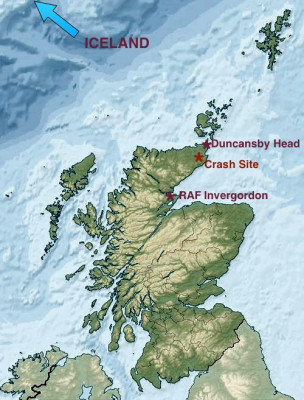
|
| Description: |
|
| Filesize: |
36.71 KB |
| Viewed: |
315 Time(s) |
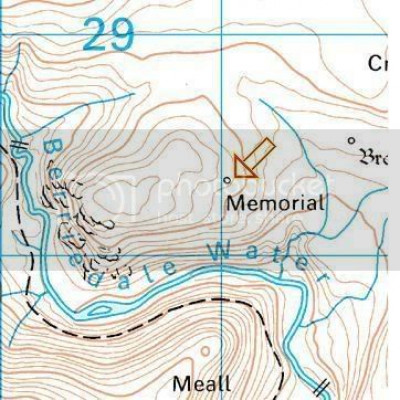
|
_________________
www.lawyerscommitteefor9-11inquiry.org
www.rethink911.org
www.patriotsquestion911.com
www.actorsandartistsfor911truth.org
www.mediafor911truth.org
www.pilotsfor911truth.org
www.mp911truth.org
www.ae911truth.org
www.rl911truth.org
www.stj911.org
www.v911t.org
www.thisweek.org.uk
www.abolishwar.org.uk
www.elementary.org.uk
www.radio4all.net/index.php/contributor/2149
http://utangente.free.fr/2003/media2003.pdf
"The maintenance of secrets acts like a psychic poison which alienates the possessor from the community" Carl Jung
https://37.220.108.147/members/www.bilderberg.org/phpBB2/ |
|
| Back to top |
|
 |
TonyGosling
Editor


Joined: 25 Jul 2005
Posts: 18335
Location: St. Pauls, Bristol, England
|
|
| Back to top |
|
 |
TonyGosling
Editor


Joined: 25 Jul 2005
Posts: 18335
Location: St. Pauls, Bristol, England
|
 Posted: Fri Mar 19, 2021 12:43 am Post subject: Posted: Fri Mar 19, 2021 12:43 am Post subject: |
 |
|
Prince George, Duke of Kent
https://spartacus-educational.com/2WWkentD.htm
George Saxe-Coburg-Gotha was born on 20th December 1902 at York Cottage on the Sandringham Estate. His father, George, Prince of Wales, was the son of Edward VII and Queen Alexandra. At the time of his birth, George was fifth in the line of succession.
Edward VII died in 1910 and Prince George's father, George V became the new king. The outbreak of the First World War created problems for the royal family because of its German background. Owing to strong anti-German feeling in Britain, it was decided to change the name of the royal family from Saxe-Coburg-Gotha to Windsor. To stress his support for the British, the king made several visits to the Western Front. On one visit to France in 1915 he fell off his horse and broke his pelvis.
At the age of thirteen Prince George went to Osborne Naval College. Later he transferred to Dartmouth College and served in the Royal Navy on board the Iron Duke and the Nelson.
In 1917 George V took the controversial decision to deny political asylum to the Tsar Nicholas II and his family after the Bolshevik Revolution. People where shocked by George's unwillingness to protect his cousin but his advisers argued that it was important for the king to distance himself from the autocratic Russian royal family. Some people questioned this decision when it became known that the Bolsheviks had executed Tsar Nicholas, his wife and their five children.
In 1924 George V appointed Ramsay MacDonald, Britain's first Labour Prime Minister. Two years later he played an important role in persuading the Conservative Government not to take an unduly aggressive attitude towards the unions during the General Strike.
Prince George remained in the Royal Navy until 1929. He then held posts in the Foreign Office and the Home Office. In 1934 George married Princess of Marina of Yugoslavia. At the same time he was granted the title of the Duke of Kent. Like his brother Edward, the Duke of Kent was sympathetic to the political developments that were taking place in Nazi Germany.
George V died of influenza on 20th January, 1936. George's brother, Edward VIII now became king. At the time he was having a relationship with Wallis Simpson. The government instructed the British press not to refer to the relationship. The prime minister, Stanley Baldwin, urged the king to consider the constitutional problems of marrying a divorced woman.
Although the king received the political support from Winston Churchill and Lord Beaverbrook, he was aware that his decision to marry Wallis Simpson would be unpopular with the British public. The Archbishop of Canterbury also made it clear he was strongly opposed to the king's relationship.
The government was also aware that Simpson was in fact involved in other sexual relationships. This included a married car mechanic and salesman called Guy Trundle and Edward Fitzgerald, Duke of Leinster. More importantly, the Federal Bureau of Investigation believed that Simpson was having a relationship with Joachim von Ribbentrop, the German Ambassador to Britain, and that she was passing secret information obtained from the king to the Nazi government.
On 10th December, 1936, the king signed a document that stated he he had renounced "the throne for myself and my descendants." The following day he made a radio broadcast where he told the nation that he had abdicated because he found he could not "discharge the duties of king as I would wish to do without the help and support of the woman I love."
George VI now became king and the coronation took place on 12th May, 1937. Later that month, Neville Chamberlain replaced Stanley Baldwin as prime-minister. The following year Chamberlain travelled to Nazi Germany to meet Adolf Hitler in an attempt to avoid war between the two countries.
The result of Chamberlain's appeasement policy was the signing of the Munich Agreement. George VI wrote to Chamberlain on hearing the news: "I am sending this letter by my Lord Chamberlain, to ask you if you will come straight to Buckingham Palace, so that I can express to you personally my most heartfelt congratulations on the success of your visit to Munich. In the meantime this letter brings the warmest of welcomes to one who by his patience and determination has earned the lasting gratitude of his fellow countrymen throughout the Empire."
Prince George shared his brother's view of appeasement and was considered the leader of the Anglo-German peace group. According to the authors of Double Standards (2001) the Duke of Kent met Rudolf Hess and Alfred Rosenberg during the 1930s. A report written by Rosenberg for Adolf Hitler in October 1935 stated that the Duke of Kent was working behind the scenes "in strengthening the pressure for a reconstruction of the Cabinet and mainly towards beginning the movement in the direction of Germany."
In February 1937 it was reported that the Duke of Kent had met the Duke of Windsor in Austria. Later that year a Foreign Office document pointed out that the Duke of Kent had developed a close relationship with Joachim von Ribbentrop, the German Ambassador in London.
By 1938 British intelligence was becoming very concerned about the activities of the Nazi spy, Princess Stephanie von Hohenlohe. A report said: "She is frequently summoned by the Führer who appreciates her intelligence and good advice. She is perhaps the only woman who can exercise any influence on him." They also reported that she seemed to be "actively recruiting these British aristocrats in order to promote Nazi sympathies." (PROKV2/1696). According to MI5 the list of people she had been associating with over the last few years included Prince George, the Duke of Windsor, Wallis Simpson, Ethel Snowden, Philip Henry Kerr (Lord Lothian), Geoffrey Dawson, Hugh Grosvenor, 2nd Duke of Westminster, Charles Vane-Tempest-Stewart, 7th Marquess of Londonderry, Ronald Nall-Cain, 2nd Baron Brocket, Lady Maud Cunard and Walter Rothschild, 2nd Baron Rothschild. In August 1938 French intelligence, the Deuxième Bureau, told MI6 that it was almost certain that Princess Stephanie was an important German agent.
The Duke of Kent took part in secret talks with his cousin Prince Philip of Hesse in early 1939 in order to avoid a war with Nazi Germany. In July 1939, the Duke of Kent he approached George VI with a plan to negotiate directly with Adolf Hitler. The king, who supported the idea, spoke to Neville Chamberlain and Lord Halifax about the plan.
On the outbreak of the Second World War the Duke of Kent and his family moved to Scotland, living in Pitliver House, near Rosyth, in Fife. He returned to active military service at the rank of Rear Admiral, briefly serving on the Intelligence Division of the Admiralty. In April 1940, he transferred to the Royal Air Force. He took the post of Staff Officer in the RAF Training Command at the rank of Air Commodore.
In 1940 the Duke of Kent travelled to Lisbon to meet the dictator of Portugal, Antonio Salazar. The Duke of Windsor, who was in Madrid at the time, planned to meet his brother while he was in Lisbon. British officials were instructed to prevent the former king from going to Portugal until the Duke of Kent had left the country.
On 10th May, 1941, Rudolf Hess flew a Me 110 to Scotland with the intention of having a meeting with the Duke of Hamilton. Hess hoped that Hamilton would arrange for him to meet George VI. According to the authors of Double Standards (2001) the Duke of Kent was with Hamilton at his home (Dungavel House) on the night that Hess arrived in Scotland. As the Duke of Kent's papers are embargoed it is impossible to confirm this story. However, we do know from other sources he was at RAF Sumburgh in the Shetlands on the 9th and at Balmoral in Scotland on the 11th of May. The following day he was at RAF Wick at Caithness. He was therefore definitely in that area during this period.
The Duke of Hamilton's diary records several meetings with the Duke of Kent during the early months of 1941. Elizabeth Byrd worked as a secretary for Hamilton's brother Lord Malcolm Douglas-Hamilton. She claims he told her that the Duke of Hamilton took the "flak for the whole Hess affair in order to protect others even higher up the social scale". Byrd added that "he (Lord Malcolm) had strongly hinted that the cover-up was necessary to protect the reputations of members of the Royal Family".
On 25th August 1942, Prince George, Duke of Kent, took off from Invergordon in an S-25 Sunderland Mk III Flying Boat. The official story is the Duke was on a morale-boosting visit to RAF personnel stationed in Iceland. The crew had been carefully selected for the task. The captain, Flight Lieutenant Frank Goyen, was considered to be Sunderland flyer in the RAF and had flown some of Britain’s politicians during the war. The rest of the crew was also highly regarded. The co-pilot was Wing Commander Thomas Lawton Mosley, the commanding officer of 228 Squadron. Mosley was one of the RAF’s most experienced pilots having completed 1,449 flying hours. He was also a navigation specialist and was a former instructor at the School of Navigation.
Officially the Duke of Kent was one of fifteen people on board the aircraft. Also on board were Prince George’s private secretary (John Lowther), his equerry (Michael Strutt) and his valet (John Hales).
The flying boat took off from Invergordon on the east coast of Scotland at 1.10 p.m. Being a flying boat, its standing orders were to fly over water, only crossing land when absolutely unavoidable. The route was to follow the coastline to Duncansby Head – the northernmost tip of Scotland – and then turn northwest over the Pentland Firth towards Iceland.
The S-25 Sunderland Mk III crashed into Eagle’s Rock later that afternoon (there is much dispute about the exact time this happened) at a height of around 650 feet. As you can see from the map below, the flying boat was well off course when the accident happened. Its 2,500 gallons of fuel, carried in the wings, exploded.
The route of the S-25 Sunderland Mk III on 25th August, 1942.
The route of the S-25 Sunderland Mk III on 25th August, 1942.
This raises some important questions. Why did the pilot take the flying boat off course? It was a clear day and he would be fully aware that he was now flying over land rather than the sea. Why, when the aircraft included four experienced navigators, did the aircraft drift a huge 15 degrees off course from its point of departure? Why did he descend to 650 feet when he was flying over high land? This is especially puzzling when one considers that the S-25 Sunderland Mk III had one major defect – it was sluggish when climbing – especially when heavily laden, as it was on the Duke of Kent’s flight.
The crash was heard by local people and reached the scene of the accident about 90 minutes after they heard the explosion. This included a doctor (John Kennedy) and two policemen (Will Bethune and James Sutherland). They found 15 bodies. This included the body of the Duke of Kent. Bethune gave a radio interview in 1985 where he described finding Prince George’s body. He said that handcuffed to the Duke’s wrist was an attaché case that had burst open, scattering a large number of hundred-kroner notes over the hillside.
The Duchess of Kent, collapsed in shock when she heard the news. The following morning the newspapers reported that everyone on board the Sunderland had been killed. Telegrams were sent to the next of kin of all members of the crew. However, later that day it emerged that Andy Jack, the tail-gunner, had been found in a crofter’s cottage at Ramscraigs. Apparently, when the flying boat exploded, the tail section was thrown over the brow of the hill, coming to rest in the peat bog on the other side. Andy Jack only had superficial injuries. What he did next was very surprising. Instead of going to the wreckage to see what had happened to his colleagues, and waiting for rescuers to arrive, he ran away in the opposite direction. This of course was in direct contravention of standard procedure – which was always to remain with the wreck. Andy Jack eventually found an isolated crofter’s cottage. The owner, Elsie Sutherland alerted Dr. John Kennedy by telephone. However, it was sometime before this information reached the authorities. Andy Jack’s sister Jean had already received a telegram telling her that her brother had been killed in the accident.
Winston Churchill made a statement in the House of Commons where he described the Duke of Kent as “a gallant and handsome prince”. Of the many tributes and messages of condolence received from other countries, the most significant was from General Wladyslaw Sikorski, the head of the Polish government in exile. The two men were very close and Sikorski sent a special dispatch to all Polish troops in Britain where he described the Duke as “a proven friend of Poland and the Polish armed forces”.
The Duchess of Kent visited Andy Jack several times after the death of her husband. It is believed that the information he provided influenced what was inscribed on the Duke of George’s memorial. This included the following: “In memory of…. the Duke of Kent… and his companions who lost their lives on active service during a flight to Iceland on a special mission on 25th August 1942”. The use of the words “special mission” is an interesting one. It was also the words used by Pilot Officer George Saunders, who also died in the crash. In 2001 Peter Brown, the nephew of Saunders, told a researcher that he was told that in August 1942, Saunders went home to see his family in Sheffield. Saunders informed his mother: “I’m just on leave for a couple of days. I’m going on a most important mission, very secret. I can’t say any more.”
A court of inquiry was held and details of their findings were presented in the House of Commons by the Secretary of State for Air, Archibald Sinclair, on 7th October 1942. The conclusion of the report was: “Accident due to aircraft being on wrong track at too low altitude to clear rising ground on track. Captain of aircraft changed flight-plan for reasons unknown and descended through cloud without making sure he was over water and crashed.”
Sinclair confirmed that weather conditions were fine and there was no evidence of mechanical failure. He added “the responsibility for this serious mistake in airmanship lies with the captain of the aircraft”. It was therefore suggested that the reason for the crash was the team of four pilot/navigators drifted off course and then failed to reach the necessary height to clear Eagle Rock.
The problem is that the documents that would enable researchers to re-examine the evidence have vanished. This includes the flight plan filed by Goyen before take-off.
The secret court of inquiry should have been made available after 15 years. When researchers asked the Public Record Office in 1990 for a copy of the report it was discovered that it had gone missing. The PRO suggested it might have been transferred to the royal archives at Windsor Castle. However, the registrar of the royal archives denies they have ever had the report.
Andy Jack, the only survivor of the crash, was forced to sign the Official Secrets Act while still in hospital. He later told his sister that he could not talk about the crash because he had been “sworn to secrecy”. Jean Jack did provide researchers with one piece of interesting information about the case. Frank Goyen gave Andy Jack a signed photograph of himself just before take-off on which he had written: “With memories of happier days.” Was this a reference to the mission they were about to undertake? Does it suggest that Goyen disapproved of the mission?
Andy Jack was promoted and after the war served in Gibraltar. While he was there he was visited several times by the Duchess of Kent. Clearly, she was still interested in finding out why her husband was killed.
On 17th May 1961 the Duchess of Kent brought the case to national attention when she visited the scene of her husband’s death. This created a discussion about the crash in the media. Andy Jack now came forward to give an interview to the Scottish Daily Express. He was still serving with the RAF and not surprisingly he went along with the conclusions of the official inquiry. He retired from the RAF on a good pension in 1964. However, he drunk away his money and died of cirrhosis of the liver at the age of fifty-seven.
An important witness to the crash was Captain E. E. Fresson. He piloted an aircraft over the same area and at around the same time as the crashed Flying Boat. The following day he took the only aerial photographs of the wreckage. In 1963 Fresson published his autobiography, Air Road to the Isles. Amazingly, the book does not refer to the death of the Duke of Kent. According to his son, Richard Fresson, the book originally included a full chapter that covered his investigation into the crash. However, this material was removed by the publishers at the last moment.
There is also another interesting aspect to this story. Just ten days after the death of the Duke of Kent, another flying boat, also from 228 Squadron, crashed in the Scottish Highlands. The official explanation was that the plane had run out of fuel. Everyone on board was killed, including a very interesting passenger, Fred Nancarrow, a journalist from Glasgow. Nancarrow was investigating the Eagle Rock crash.
_________________
www.lawyerscommitteefor9-11inquiry.org
www.rethink911.org
www.patriotsquestion911.com
www.actorsandartistsfor911truth.org
www.mediafor911truth.org
www.pilotsfor911truth.org
www.mp911truth.org
www.ae911truth.org
www.rl911truth.org
www.stj911.org
www.v911t.org
www.thisweek.org.uk
www.abolishwar.org.uk
www.elementary.org.uk
www.radio4all.net/index.php/contributor/2149
http://utangente.free.fr/2003/media2003.pdf
"The maintenance of secrets acts like a psychic poison which alienates the possessor from the community" Carl Jung
https://37.220.108.147/members/www.bilderberg.org/phpBB2/ |
|
| Back to top |
|
 |
|






